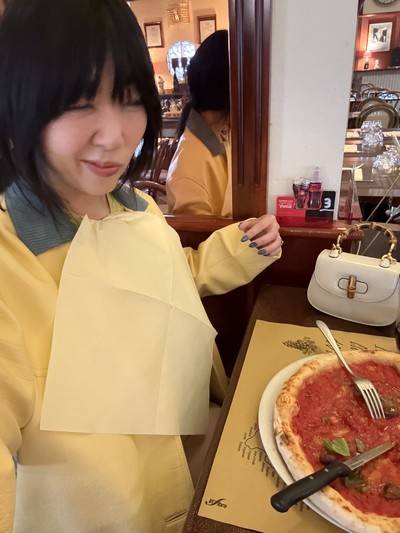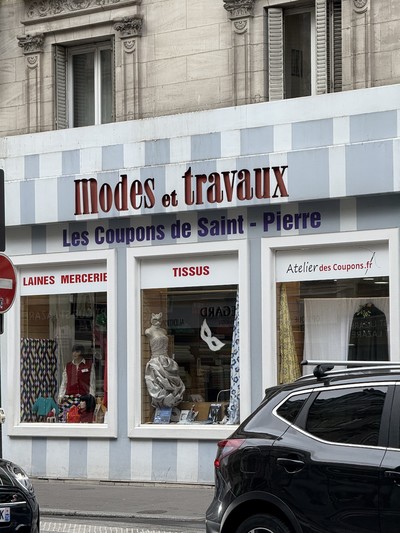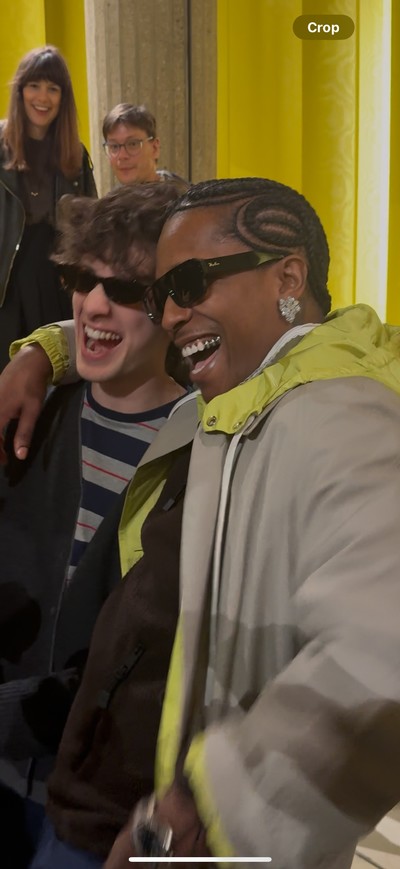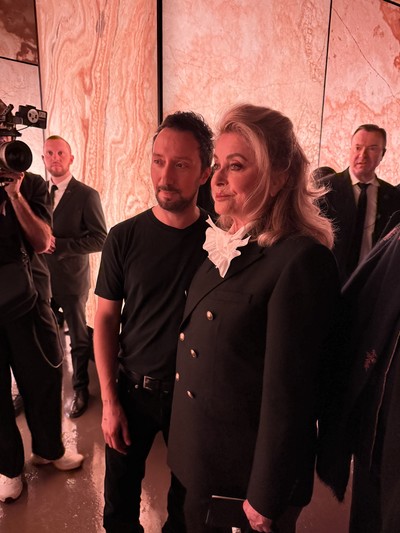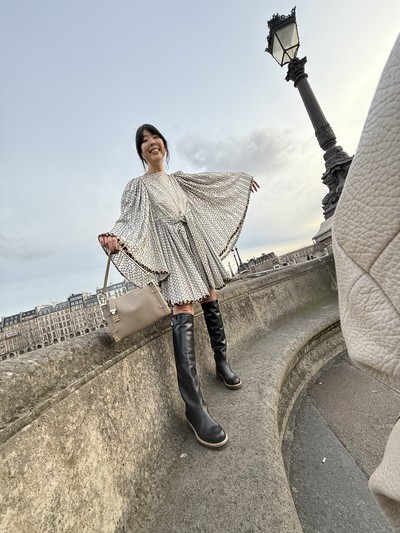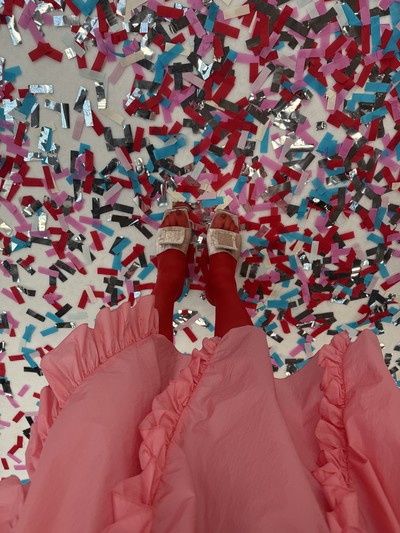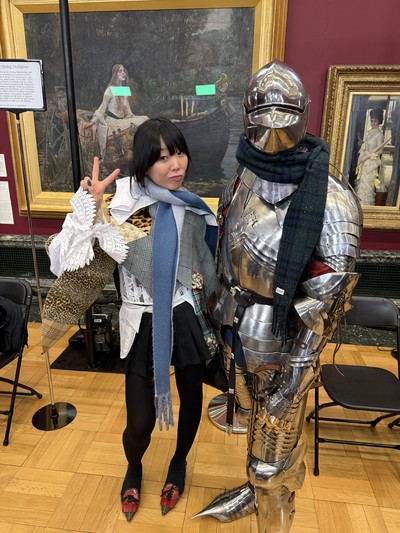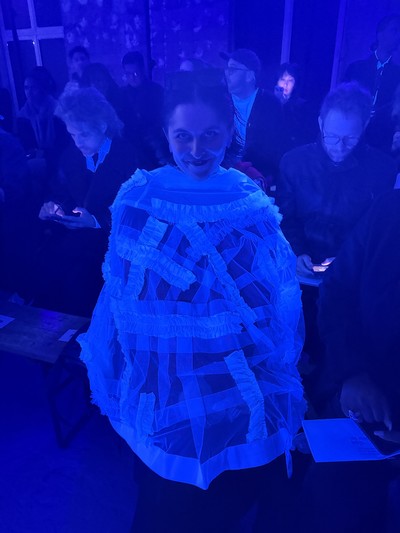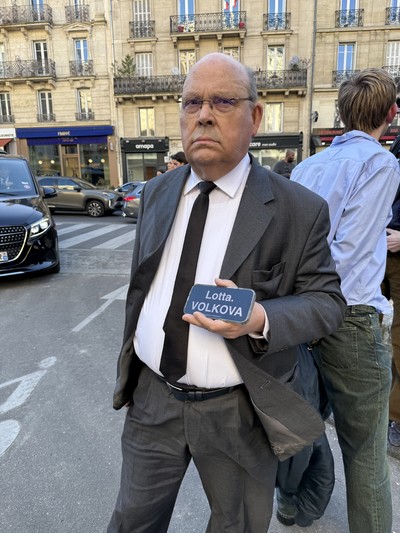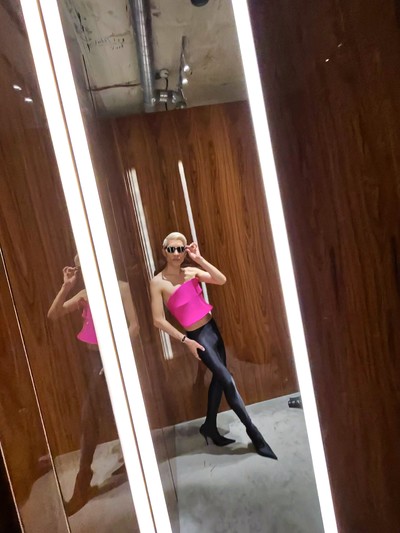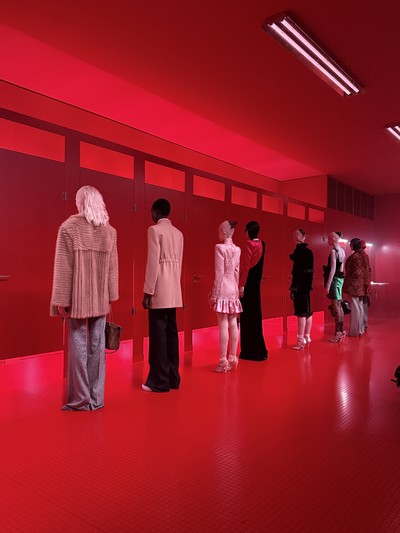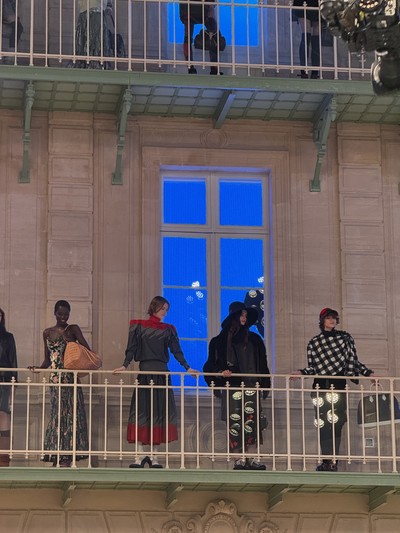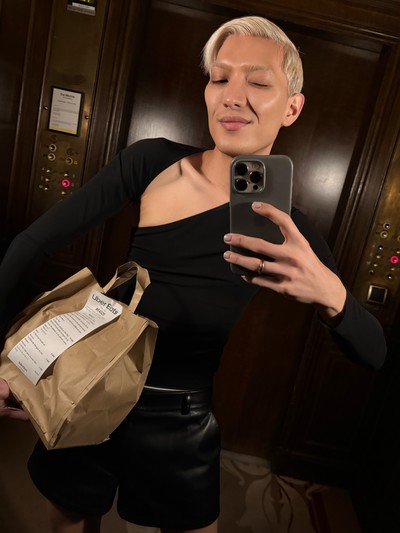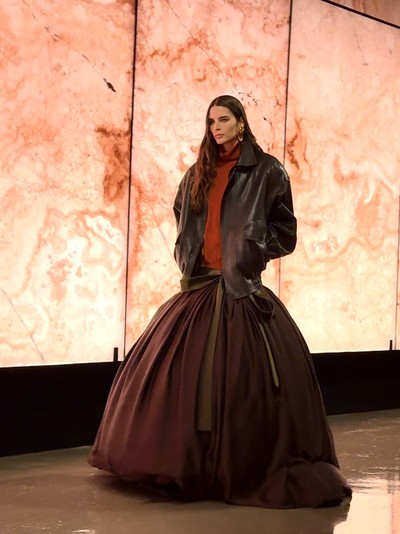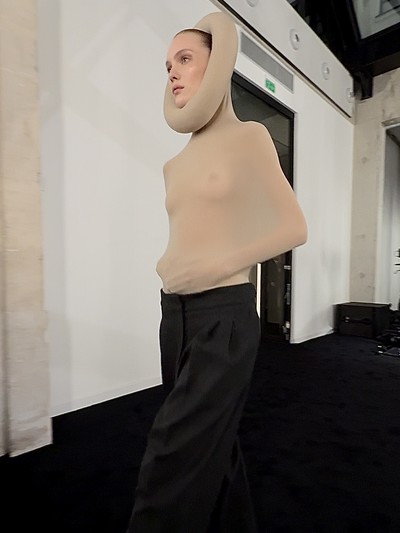‘All these rumours that are circulating – about the comings and goings of the designers – have social media pundits and even traditional press wading in with clickbait for views. I mean, why are we talking about personnel more than the actual collections? Why all the attention? We’re not HR Weekly.’
Bryan and I met up in his hotel room at The Westin just after the Miu Miu show had finished on the last day of Paris Fashion Week. We had one more show to see – Saint Laurent, the new closer to fashion month. We didn’t get a chance to debrief it despite us both agreeing it was a pretty stellar show by Anthony Vaccarello. Ballooning and exalting, and new territory for Vaccarello during a season where boldness felt not just welcome, but necessary.
Being safe won’t cut through the noise, especially as the noise mostly concerns comings and goings of creative directors at the fashion houses. Immediately after the shows, it was announced Demna would be the new creative director at Gucci. Bryan actually may have called it first because at the Balenciaga show, he noted that Demna was wearing a suit. ‘He’s in a new era,’ he said. Jonathan Anderson hadn’t yet been announced as creative director of Dior Menswear, with potentially more to come.
Bryan and I wondered why fashion weeks felt increasingly like a regular debrief of the United Human Resources Department of Fashion and how all this information of C-suite changes affected the creative ether. I feel tired looking at all the countless Instagram slideshows reporting the changes that were coming out during fashion week and after. Then we quickly realized we’re part of the problem. Or at least, our generation of content creators chipped away at the floodgates of information that was to be unleashed later on.
There was much to be hopeful for, though. Both myself and Bryan, the self-confessed ‘Department of Corporations lady’– and, in his day job, Perfect magazine’s editor-in-chief – began and ended our conversation enthusing endlessly about Duran Lantink, who would later be announced as Jean Paul Gaultier’s new permanent creative director. It felt good to see a buzzy show where C-suite changes don’t have to figure into the conversation. And so we landed on excitement as we both anticipated what’s to come. Final acts. Visions bedding in. Debuts. ‘Goodbye my friend, it’s not the end…’
Bryan Yambao: Hi Susie, welcome to my hotel room.
Susie Lau: Well, thank you so much for sitting down with me for a System Collections debrief of Autumn/Winter 2025. I feel like a lot of people didn’t have very high expectations going into this season. A few editors that I spoke to were like, ‘Well, it’s the transition season.’ There’s so many changes going on. How did the season turn out for you?
Bryan: Oh, that’s a loaded question. I mean, for me personally, there are a few gems. I think when you go to the weeks to watch a lot of shows, it’s the same as every season. There’s a lot of noise. There was a lot of flatness, but also there’s standouts. I think my show of the season was Duran Lantink.
Susie: I think that was a lot of people’s show of the season. And I wondered why? Well, obviously, Duran is very talented. I’ve been following his work from his very beginnings.
Bryan: I haven’t.
Susie: What was it about this particular one that just got everyone excited?
Bryan: I thought that was an amazing show. But when you go on socials, the coverage was mainly focused on the breastplates; Mica in the top made out of silicone. People were looking for that viral moment and reducing a brilliant show – with amazing silhouettes and textures and shapes and proportions – to a five-second reel of bouncing tits.
Susie: This was one of those examples of a show where I think you had to actually be there to experience the whole scope. Like the opera singers singing in their cubicles.
Bryan: And the body make-up that you can’t really tell if it’s a tattoo or something that’s printed on. I mean, everything just hit the right spot. It was sensory overload. All of the check boxes are there for me. It was humorous and funny. We just love something that stimulates us. And I thought that was really stimulating, both visually and emotionally.
Susie: It’s great to see that the best show of the season doesn’t necessarily have to be from a big house.
Bryan: I like to say I am more like a ‘Department of Corporations’ kind of lady. She loves to go to the big houses, you know what I mean. But particularly this season, I tried to make a conscious effort to go explore young designers. I used to do this when I first started, I would go to everything, but then one’s priorities change. Young designers definitely need the spotlight though. It’s not unexpected to see this coming from a young designer, because don’t forget: the bigger the brand, the more control a house will have in terms of merchandising in the commercial department. So a designer can’t fully express themselves as creatively as Duran did.
‘There’s been a big focus on sex and sensuality this season. A sense of femininity and the female body – just look at Miu Miu, Alaïa, Duran and Dior.’
Susie: OK, so who do you think in the big houses really went for it?
Bryan: Silvia at Fendi, for sure…
Susie: Which is also kind of unexpected, because we’re talking about someone who’s been with the house forever.
Bryan: And she still has it!
Susie: It’s amazing to see her have the house to herself again. And even though I do like that co-creative director structure, after this show I kind of ended up thinking: does she need an artistic director?
Bryan: She should just have the house to herself and embrace it. What I loved about that show is that they went full-on, no holds barred. They really celebrated fur and shearling. Maybe not so much fur, but they had a few minks. Don’t forget, Fendi is a fashion house based on fur. And it’s nice to see a house embrace their DNA, embrace who they truly are in a season when a lot of houses are putting out fake fur. Why not go for something more sustainable and environmentally friendly – the real thing?
Susie: I saw faux fur everywhere. Everyone was doing fake bourgeois. Some people did it really fun, like when Simone Rocha did these fur rabbits, and hares. But then it just kept on coming.
Bryan: Why do you think that is?
Susie: Everyone was talking about the boom aesthetic, the hangover of mob wife. And then maybe Gen Z aren’t so anti-fur, because the faux stuff is actually polluting, as it’s made out of plastics. But I also think it’s just very traditional and safe. With a lot of houses pulling back creatively, fur seems to be like this kind of cozy cocoon.
Bryan: But they’re not even bringing out, like, real fur.
Susie: It’s just aesthetic – the look of it.
Bryan: So basically you have a new generation, Gen Z and Gen Alpha, buying vintage, real furs, going for that aesthetic, and then you have fashion houses responding to that by putting out fake fur. Make it make sense!
Susie: But a lot of them have already made their no-fur policy, and they’ve obviously got to stick to it. I don’t think it’s one of those things that you can cycle back on. I’m not sure how productive it is to also promote the look of fur with faux fur. I’m not a fur wearer or promoter myself.
Bryan: In a way, fashion is responding to what the new generation is buying, rather than setting the tone.
‘After 11 years of creating his own Loewe codes, Jonathan’s moving to Dior. So do you remain loyal to the designer, or to the house he’s left behind?’
Susie: Another thing a few designers have talked about this season is the fact that we’re in a tough situation. Miuccia actually said backstage after Miu Miu, ‘We’re at war.’ Designers aren’t responding to it directly, except for Miuccia, who I thought did it in the most overt kind of obvious way.
Bryan: It was very feminine, sexual…
Susie: But with this wartime kind of aesthetic, something that was very 1930s, 1940s, which she loves doing. Then she was asking questions about the presence of the cones and the bras. Are they relevant today? Do they help? Do they lift us up?
Bryan: If anything, there’s a big focus on sex and sensuality this season. That’s what I’m noticing. A lot of the collections I’ve seen have this sense of femininity to them. It’s something about the body, like the Alaïa show. Also at Dior. I thought that was a very good Maria Grazia show.
Susie: I loved the show. Have you watched the documentary that she just did with Loic Prigent, Her Dior?
Bryan: I missed that.
Susie: Obviously, we don’t know what’s happening yet…
Bryan: We do know what’s happening.
Susie: We sense that her time there is coming to an end. So I watched that film, and I thought about what Maria Grazia has achieved. It is remarkable. And I don’t think she really gets her dues, which I think is such a shame. Financials aside, what she’s brought into the conversation about female artists, uplifting those voices, giving them those platforms, and then really giving women clothes that they want to wear… I only wish, with the latest show, that we got to see it a little closer. There were a lot of theatrics going on with the Bob Wilson scenography.
Bryan: The flying pterodactyl…
Susie: Fireworks, crystals, dry ice. It was a lot. I wish I could have seen the clothes closer. A lot of designers were doing smaller, more intimate shows.
Bryan: But were they though? I mean, maybe according to a Vogue Business article. It’s fascinating when looking at media reports, and social media commentary talking about how the brands are scaling back, how the shows are more intimate. Louis Vuitton, for example, had 300 or 400 people. Miu Miu got smaller, but then when you’re actually there, it doesn’t feel like it. You see the same key players at the shows. You see a lot of the editor-in-chiefs, but maybe the fashion directors are not there. It still feels huge, and then there’s more and more people outside. It’s insane.
Susie: I think it’s more about the choices that they make in seating. It’s more strategic with who they invite. And the crowds outside Miu Miu were crazy. They had A$AP Rocky turning up to the show. But that feeling of intimacy, it’s a specific strategy to gatekeep certain shows, to communicate this idea of, ‘This is a very special house. This is a very special collection that you’re seeing.’ And that’s how the brand wants to communicate that to the outside world.
Bryan: But will that actually work in this day and age of fame and clickbait and numbers and viral moments?
Susie: So you and I didn’t go to Tom Ford, for example. I would love to have seen it. I heard it was good. It looked good on video. That somehow didn’t translate when I looked at the pictures. I felt like I needed to take another look.
Bryan: At the same time, do you think it’s also a generational thing? Tom Ford is a brand and a house that’s associated with a certain generation. And when a lot of the show-goers or guests belong to that generation, there’s a sense that you’re nostalgic for something that existed previously. I mean, we weren’t going to the original Tom Ford Gucci shows. We weren’t there. But obviously those original Tom Ford shows were so groundbreaking that to this day they’re still very influential.
Susie: Massively referenced.
‘Alessandro Michele has conviction. He really stands by the beautiful things he creates. I bought two Valentino turbans and lace gloves the other day.’
Bryan: And even with Haider, I have so much respect for him. And you know, what he created in the past is also impressive. I would have loved to see it in person, because it’s hard to judge if you’re not there in the room… but it’s a different aesthetic. I need to see a show that’s rooted in the now, or relevant for the now, and something that has ties to the zeitgeist. Would an 18-year-old get that show? Maybe it’s not for a younger generation, in a way.
Susie: With that kind of gatekeeping element, I do think it is a strategy that brands lean on. Like The Row has done it forever, and this season it was even more stringent. A journalist I was sitting next to said she took a video of just her notebook with the models’ feet blurred in the background. But the PR asked her to take it down and delete the video from her phone. The video was of her notebook. You couldn’t even see anything clearly in the background!
Bryan: It’s like censorship, in a way.
Susie: It’s this push and pull of wanting intimacy and exclusivity, which might have a counterproductive effect on the people who are needing to shoot it and see it and write about it. I don’t know if it’s like a one-off season thing or if it’s actually a budget issue…
Bryan: For The Row it’s never a budget issue. It’s really a gatekept brand.
Susie: Because putting on a small show is not actually any cheaper than putting on a bigger show.
Bryan: I don’t go to all the shows, obviously, and I don’t want to take a seat away from someone who wants to be there or deserves to be there. And I usually go to the shows where I have an emotional and a personal connection with the designer. I’m either a huge fan or there’s a working relationship. As communicators, we want to see as much as we can, but it’s impossible to do it all. Would you have loved to see The Row? Is there a desire for you to be there, knowing your limitations and what you can do?
Susie: I’m not sure they would have me, but I guess it’s not a brand that I’m personally connected to in any way. And if I don’t have to go in a professional capacity, then for me it’s totally fine.
Bryan: Do you own an item of clothing from The Row?
Susie: I do not. I can appreciate things from a distance though. That goes back to that thing of: if you didn’t get invited, or if you weren’t at the show, can you still appreciate it from afar? In some ways, brands are maybe banking on editors and stylists to appreciate things from afar, even if they can’t always be invited to the show.
Bryan: I mean, I can.
‘I don’t think Maria Grazia gets her dues. Besides financials, she’s brought female artists to the fore, and given women clothes they actually want to wear.’
Susie: What did I like from afar? I didn’t go to many shows in Milan, but I loved a lot of the things that I didn’t see. I liked Dsquared2.
Bryan: Dsquared2 was incredible.
Susie: I liked the little collaborations they did with Vaquera and Magliano and Bettter3 – very cute and fun and by all accounts kitsch and funny.
Bryan: I also liked Max Mara. I have so much respect for Ian [Griffiths]. They don’t have to please everyone, and they don’t. They don’t want to come up with insane concepts just to satisfy people who are hungry for a viral moment. You know you don’t need a viral moment at a Max Mara show.
Susie: I like shows where you feel very much the presence of the designer, and that it comes from them. With some designers you can sense when they are dialling it in a bit. When it doesn’t feel of the heart. I always think Miu Miu is a really good closer. And I thought that show really came from her and you could really sense that, even without speaking to her afterwards.
Bryan: Another one that I enjoyed was the Loewe presentation.
Susie: OK, so we need to talk about that, because he [Jonathan Anderson] wasn’t at the presentation. By all accounts, I think it’s pretty clear that he’s left the building.
Bryan: [Sings the Spice Girls’ ‘Goodbye’] Goodbye my friend, it’s not the end.
Susie: I hope no one from the Spice Girls – Victoria – is watching or reading this. I thought it was incredible that they did a presentation, and even though he wasn’t there, it was like his spirit was there; there was so much of Jonathan’s imprint. It was kind of haunting.
Bryan: I’m actually having goosebumps, you know?
Susie: I felt sad to be honest.
Bryan: I’m grieving.
Susie: Because it’s the end of an era at Loewe. But I’m also very excited for what’s to come as well. When you have so much respect for a designer and their work and what they bring into the house… I mean, essentially, they work for a brand. And Jonathan literally obliterated what Loewe was and made his own imprint. Eleven years of creating his own codes, modernizing it, making it relevant, making it all about his craft. He’s an incredible guy with clearly a brilliant mind and all of it is gone. He will move to another house. So what do you make out of it? Do you remain loyal to the designer, as opposed to the house that he worked for? It’s very confusing. And what do they make out of Loewe next? What should Loewe be about? In these different transitions, some creative directors have certain remits. The powers that be – the CEO, merchandising team – want things to remain constant. I’d find it hard to believe Loewe would get rid of the Puzzle bag.
Bryan: They’re never going to get rid of the Puzzle bag.
Susie: With all the transitions, I’ve been thinking about the idea that continuity is a good thing. I don’t necessarily think it’s helpful to have such a stark contrast of change – as we’ve seen at Gucci. It went from Alessandro maximalism and a very specific aesthetic to something…
Bryan: …polar opposite: minimal, sleek.
Susie: It’s something that didn’t translate for the consumer. It is a little bit dangerous to play with these kinds of 180° creative director changes.
Bryan: But don’t forget, there’s also very few visionary creative directors that can actually do that, and have such a defined aesthetic and point of view.
Susie: And brands need time to bed visions in, to let things percolate. I think Burberry, for example, are really bedding Daniel Lee in – it looked a lot better this season –and it doesn’t make any sense to me that they’d change it again after such a short period of time.
Bryan: Nothing is really successful overnight. Hedi at Celine took a while.
Susie: Even Jonathan at Loewe, it’s the same. It wasn’t kicking off in the way that it has done in the last five years.
Bryan: It takes time – one, two years minimum. So it’s sad that after a year and a half, Sabato was let go. Two weeks before the show.
Susie: I actually don’t know what to think of that period. We need to take care of people in this industry. It’s not great for people’s mental health to be dicked around like this. But, apparently he got a handsome payoff.
Bryan: I hope he did. But it’s also all of these rumours that are going on, with all the social media pundits and even traditional press taking part in it for clickbait and views. I mean, why are we talking about personnel more than the actual collections themselves?
Susie: I literally said the same thing on Instagram.
Bryan: CMOs of brands don’t deserve to be in a [Stylenotcom] blue square or have their own WWD press release. Why does it need all this attention? We’re not HR Weekly. We should be talking about the collections rather than the changes. But it’s the state of the industry at the moment…
Susie: I just think this constant speculation is killing the mystery a bit. It feels a bit linked to the overall luxury downturn and that by opening up the facade, the allure sort of diminishes.We’re part of the problem. I was never really interested in C-suite changes, though. I’m more interested in creativity and how that happens, and getting into the minds of designers. It’s just gotten to the level where you have memes about designer changes.
Bryan: Also if you’re working in a studio with a creative director, imagine the morale and the mood of everyone in that team when you know your creative director is being talked about.
Susie: We should talk about Alessandro Michele at Valentino.
Bryan: Loved! That was a good show.
Susie: I’m resolutely a Michele stan only because, even if you might not like the aesthetic, he’s very true to himself.
Bryan: Agree. He’s a guy who has conviction in what he does. He really stands by it. He creates beautiful things. I bought two turbans and lace gloves at Valentino the other day.
Susie: I just love the frills, the bows, the excess. I like that it’s more is more is more, and it isn’t for everybody.
Bryan: Maybe some people want a classic black leather jacket from Hermès, or something like a black cashmere T-shirt from The Row. But sometimes I love a pink satin turban and a black lace glove with pearls. That’s the beauty of fashion: there’s something for everybody, and I hope it remains that way; that we have designers who create things for their own community and their own customers.
Susie: Valentino is so tied to its codes: red, archives and Valentino Garavani, and I wonder if it’s at the stage where Alessandro just takes it to his own place, like how Jonathan made Loewe his own. Can we allow Alessandro to do the same thing? I’m just going off of what people have said about the show, that it’s not Valentino.
Bryan: I read something really funny the other day. It’s Gucci Allora, Valentino Ancora, you know, instead of the other way around. It would be amazing to see him push it a bit more. I think he’s paid so much respect to the Valentino archive already, even though a lot of the Internet pundits – who don’t own anything by Alessandro, don’t know anything about his work – who keep saying ‘Oh, it’s not Valentino enough.’ Instead of listening to all that noise, I just wish that he would go all out and do something that’s very him.
Susie: He is!
Bryan: Couture was incredible. It was very Valentino, but blown up to Alessandro proportions.
Susie: He’s doing his own thing, and it doesn’t feel like it’s strangled by merchandising. Like: we need to do a shoe that sells. I just hate when things look a bit strangled. I also thought this was going to be a season of transition, very tentative and a bit unsure of itself. But actually I saw some really incredible things where people just went all out, like Rei Kawakubo at Comme des Garçons, she just went for it. She always goes for it, but I felt like she really made a point that small can be beautiful, even though she’s doing these big silhouettes and brilliant embellishments.
Bryan: It’s the ultimate freedom when you own your own brand and you have financial power behind it, with Dover Street Market and everything that she does. She has the absolute freedom to not give a fuck about anyone. Same as Miuccia Prada at Miu Miu – they have so much freedom to do whatever, and it’s such a joy to see that.
Susie: I just wish everyone could have that freedom.
‘At The Row, a journalist took a video of her own notebook, with the models’ feet blurred in the background. And the PR still asked her to delete it.’
Bryan: How do you feel about one of the debuts that we forgot to touch on – Sarah Burton’s Givenchy?
Susie: It’s a really solid beginning. She’s feeling her way into the house. What I liked about is that it wasn’t just a replica of what she did at McQueen.
Bryan: No, definitely not! Was it really important to send Look No.1 in a fishnet catsuit with a logo? I mean, it’s a very strong statement.
Susie: That wasn’t my favourite part…
Bryan: Me neither, but I loved the incredible embroidery, and the tailoring.
Susie: She was one of the few designers in Paris that used mid-sized models. Backstage I saw Sarah and Yseult hugging; she seemed genuinely grateful to Sarah. It was so heartfelt, and comes from her passion to embrace femininity in all forms. I’m intrigued to see it develop, and also whether she resurrects Givenchy couture.
Bryan: I mean, she can do couture. There’s very few people who can.
Susie: I thought all the debuts were kind of great. Like Julian Klausner at Dries Van Noten. Brilliant, great succession plan. Someone who has worked with Dries, but can still do something that feels like himself as well. That was a really lovely start to the week. And then Rick, another act of freedom. He listed six designers in his press release that he worked with. I’m like, is this a Rick Owens press release, or is it a press release for other designers? I thought that was so great – to have the freedom and the generosity to give a platform to other designers. I thought about this actually: in this transitional period, what if Chanel collaborated with a young designer just for like a season? They have so much power and platform.
Bryan: Don’t forget, Chanel is so precious, and they’re very controlling of their image and their codes. They cannot. It’s an institution.
Susie: Look at Gaultier. Dior has worked with Grace Wales Bonner for Cruise collections…
Bryan: Chanel’s too precious. They work with different métiers and artisans, but for the house itself. No, I want my Chanel to stay Chanel.
Susie: Sophie Brocart is going there, from LVMH.
Bryan: For sustainability.
Susie: She’s obviously a young designer champion. I just think, ‘Share the wealth, share the love.’ Young designers are struggling. Who better to support them than big houses?
Bryan: I’m a very conservative Chanel customer, I love pure Chanel. I’m so excited about Matthieu’s first show.
Susie: Very! But that’s next season.
‘Having your own financial power behind your own brand is the ultimate freedom. Rei Kawakubo has the freedom to not give a fuck about anyone.’
Bryan: I know, but talking about today’s Chanel show, what did you think?
Susie: Very good stop gap, very heavy on accessories. I’ve noticed quite a lot of the big heavy hitters were big on accessories, like pearls, bows, all the things that are pretty. Customer catnip.
Bryan: Chanel is another house that’s so rich with codes, but Chanel has had them for a century. It’s easy to create a universe based on those codes, and you can never get sick of it. I love the idea of a simple shoe with a giant pearl on the back, on the heel. That was cute.
Susie: Those were really, really nice. And I would buy them in a heartbeat, if they produce them. I thought Vuitton was very heavy on accessories, but very kind of cute, funny, the guitar cases…
Bryan: I loved the Paris street lamp bag towards the end.
Susie: The hip pouches.
Bryan: And the shoes were really good and graphic and colorful… Even the clothes, it’s young, youthful, fresh. I really, really love Vuitton.
Susie: I thought it was nice that it was very light, because a lot of other collections were very heavy this season. Fur and waist and very restrictive, whereas, Nicolas [Ghesquière] was doing something more free-flowing, fluid and fast-paced. You could imagine them running around at the train station, on the concourse rushing to get a train.
Bryan: Maybe at Paris Charles de Gaulle, going to the first-class lounge.
Susie: You’re allergic to train stations. You’re always like, ‘I’d never take a Eurostar.’
Bryan: I’ve done it once… Trains are not really luggage friendly. Put it this way, imagine me holding four suitcases.
Susie: You don’t need luggage on a Paris-to-London commute, which a lot of people do. Jonathan Anderson must do it all the time.
Bryan: It’s useful for a day trip. But I don’t live in Paris or London. So, overall sense of this season: when everything comes to the boutiques six months from now, what would you buy?
Susie: I love that we’re talking about what we’re buying. I guess we are customers first. Editors, observers, second.
Bryan: But here’s the thing: fashion shows don’t end after the final model goes out on the runway. I mean, it’s a whole process. The shows are there, what looks are going to be produced? There are shows in some houses where you won’t see a single thing produced, because they’re going to have their own commercial versions.
Susie: But we love a show look!
Bryan: I tend to buy only show looks, if they’re available.
Susie: I would like one of those kind of lace teddy bodysuits from Valentino. They were left undone, I’d layer it obviously, but I just think they’re really cute.
Bryan: I love the Duran denims with a bare back, it’s something sexy. I’m a housewife. Do the bare bum at home, for my husband.
Susie: For his eyes only.
Bryan: Maybe I’ll do it with a thong.
Susie: Miu Miu. I loved all the rumple crumble tailoring. There’s quite a lot of rumple crumble tailoring in a few shows, actually. Prada, too.
Bryan: Were you at Hermès?
Susie: Yes. Oh, Hermès was beautiful. I thought the technique and the way that the leather was paired with the wool was really beautiful. I feel like she’s [Nadège Vanhee-Cybulski] in a sort of different era from a few seasons ago.
Bryan: Just super strong. And the good thing about Hermès is that they produce everything.
Susie: Perfect for you. You’re going to be running up a very big bill.
Susie: We’ve kind of only gone over Paris, because it’s fresh in our minds. I feel bad that I can barely remember what I saw in Milan or London. Neither of us did New York, although Marc was incredible. That was a great show from a distance.
Bryan: Let’s not lie here. If a show is remarkable and makes an impact, you’ll never forget it.
Susie: We do still have one more show left, Saint Laurent.
Bryan: Maybe that’ll be my show of the season. I bought so much Saint Laurent.
Susie: It’s nice to end fashion week by the Eiffel Tower.
Bryan: Anthony’s on a roll. It doesn’t get any more Parisian than that.
Susie: It’s bloody chic. I hate that word.
Bryan: I’ll be there with my little Saint Laurent bomber, a little tuxedo, a little heel.
Susie: I’m not that woman. But I love it from afar. And I root for him because he’s a brilliant designer.
Bryan: Another one with conviction.
Susie: To the point, where there’s a stubbornness to it.
Bryan: How many years has he been there?
Susie: Feels like more than a decade because his vision is so entrenched and established – what he does is so great.
Bryan: In this day and age of designer musical chairs, I’m just happy that there are a few people out there who are solid and still going strong, and I hope they remain that way. We need longevity.
Susie: Karl-esque longevity. Will that ever happen again?
Bryan: I mean, Ian at Max Mara has been there for quite a while, and Nadège and Véronique [Nichanian] at Hermès. But these are houses that are not trend-driven. I don’t think they’re as pressured as much as creative directors in the other groups. Max Mara is independent. Hermès is independent. Chanel, for example – Matthieu is going to have that job until he croaks.
Susie: What if he wants to leave?
Bryan: Then he can leave. But who’s going to want to leave Chanel?
Susie: That is true. There is no higher job. OK, last words. I want your takeaway from this season.
Bryan: My takeaway for the season is to spend more time with young designers.
Susie: Yay. That means that I can just give you pointers.
Bryan: I believe in instinct. I see so many images, like everybody else online, and when I saw pictures of Duran’s previous work, it really made a mark – unlike anything I’ve seen in the current landscape. And so I said, ‘OK, let me spend money on a car, drag my ass there’, and it was worth the trip. That was a very good show.
Susie: Originality still stands for something. And I think even in this season – questioning who’s coming, going, who’s beginning – it’s powerful. That’s what I felt. I feel uplifted from this week.
Bryan: Did you feel this in any other show this season? Hand on heart, you know, tell the truth.
Susie: Not especially, but I saw a lot of beautiful things. And I really, really thought that I wasn’t going to get that much. I came into this season almost being a bit Debbie Downer before it had even began. In fact, Taxi drivers have said that there have been less people in Paris for fashion week overall.
Bryan: Do you think it’s a good idea to make it all more intimate?
Susie: I think it really depends case by case. I think salon shows do look really nice with some designers. But I also don’t believe in gatekeeping for the sake of gatekeeping, to breathe this sort of ‘We’re exclusive’ sneering tone.
Bryan: You didn’t make the cut.
Susie: But brands should invite who they feel is important to them. What that means is obviously elastic. We’ll see next season.
Bryan: If we even make the cut! Well, we can always look at pictures online.
Susie: I’m sometimes so fine with a livestream and the pictures online.
Bryan: Especially if the collection’s bad.
Susie: And then you’re like, ‘Oh, OK, I’m not missing much.’ I felt bad I didn’t get to see my friend Jennyfax, a little Japanese label. I felt really bad that I didn’t get to go and see Niccolò Pasqualetti. I feel bad all the time. There is only so much time you have in the day.
Bryan: Well, speaking of time, think about all the debuts that are happening this year, all the changes…
Susie: I’m excited.
Bryan: Goodbye, my friend…
Susie: You gonna sing us out, Bryan?
